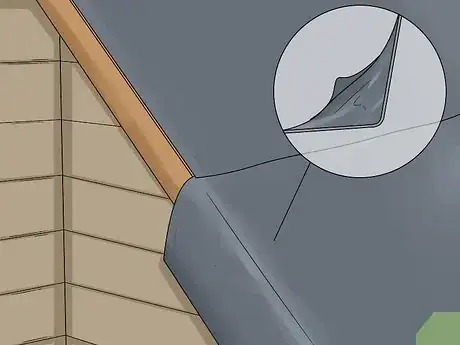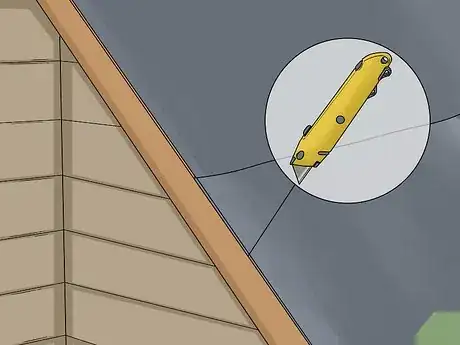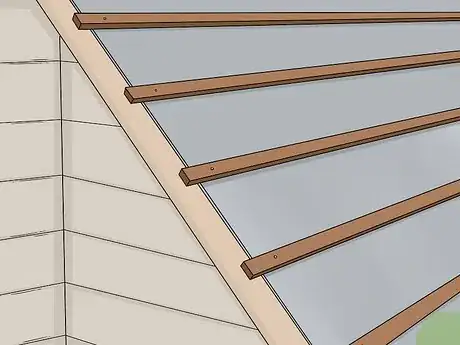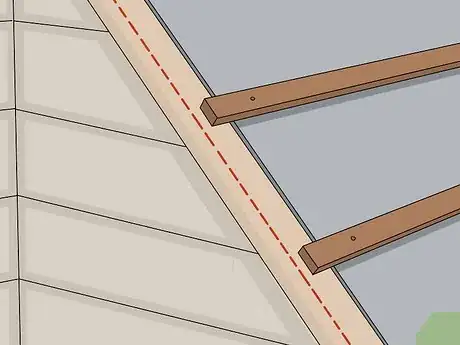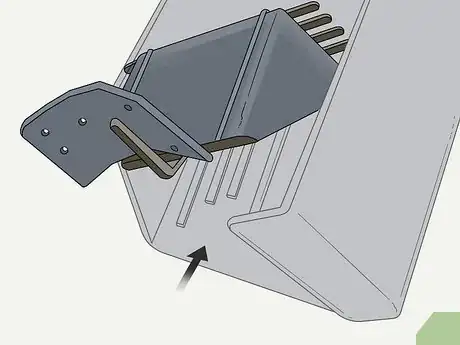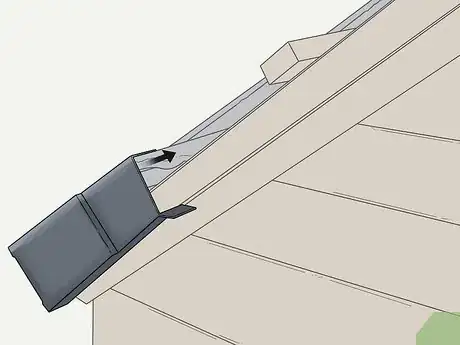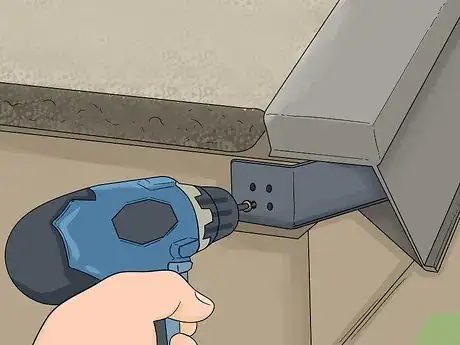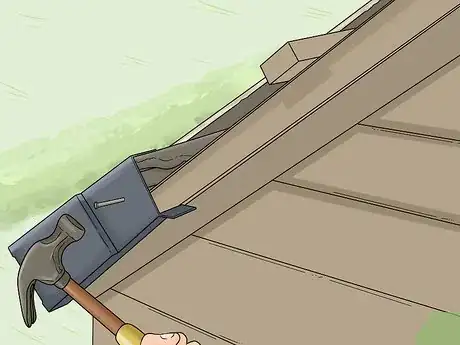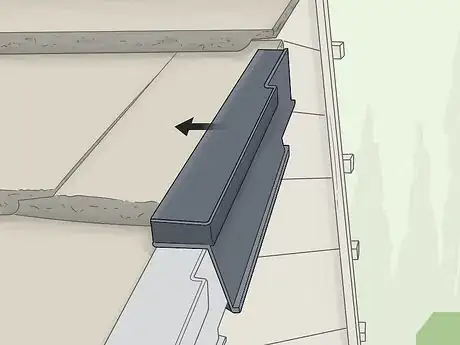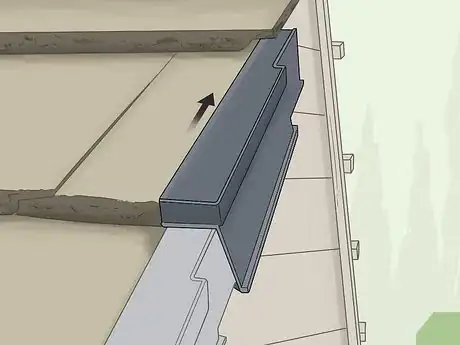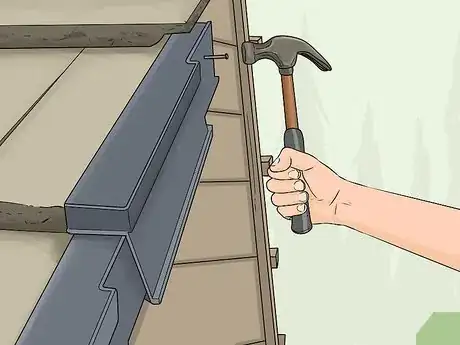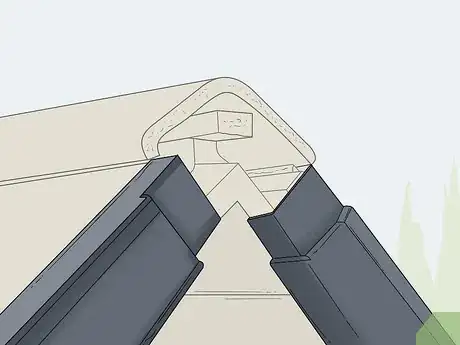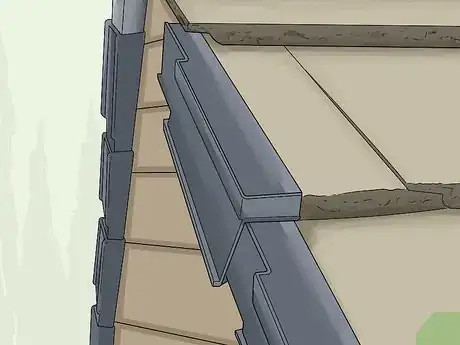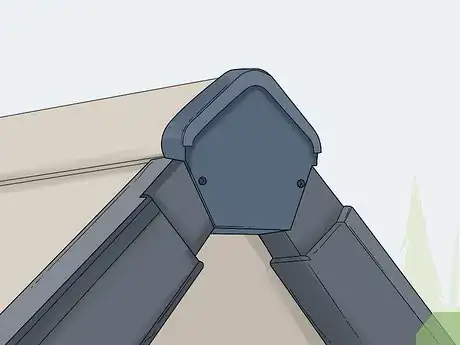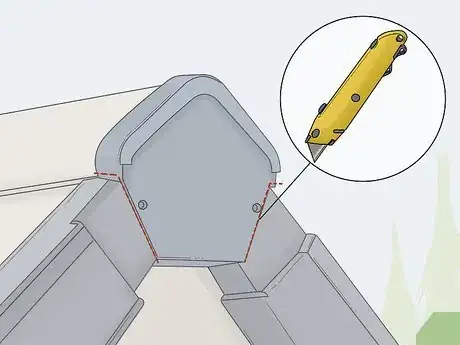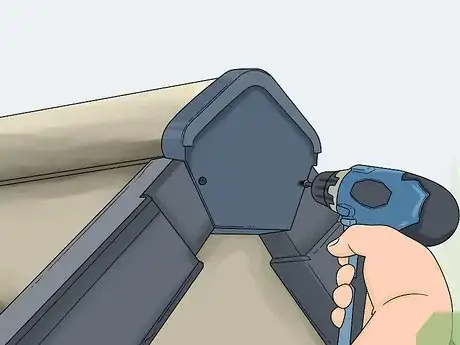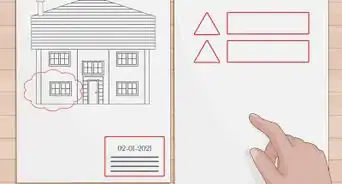This article was co-authored by wikiHow Staff. Our trained team of editors and researchers validate articles for accuracy and comprehensiveness. wikiHow's Content Management Team carefully monitors the work from our editorial staff to ensure that each article is backed by trusted research and meets our high quality standards.
There are 8 references cited in this article, which can be found at the bottom of the page.
This article has been viewed 15,454 times.
Learn more...
A roof verge is the outer edge of the very top section of a roof and is designed to prevent moisture, insects, and animals from getting into the roof. The verge begins where the outer shingles or roofing tiles end and the roof meets the gable, which is the ridge formed by the 2 sides of the roof. A dry verge is a roofing system that uses interlocking pieces to cover the verge, rather than the traditional mortar. You can fit a dry verge onto your roof with relative ease with the right tools and materials.
Steps
Battening the Verge
-
1Roll out self-stick underlayment over the verge area. Underlayment is a weather-resistant material that will protect your roof from wind and rain damage. Apply a layer of underlayment over the outer edge of the gable, also known as the verge area, by peeling off the backing to expose the adhesive and then rolling it out over the surface. The underlayment needs to cover the area completely and the material will stick to itself to form a seal.[1]
- You can find self-stick underlayment at home improvement stores, hardware stores, and online.
- If there are already shingles on the verge where you plan to install your dry verge, pull them off so you can apply the underlayment and install your verge.
-
2Cut away any excess underlayment with a utility knife. Trim the edges of the underlayment after you roll it out so they’re flush and even with the outer edge of the roof. Take a utility knife and cut along the edges to cut away the excess and form an even line.[2]
- Press down on the edges as you cut away the excess to seal them to the roof.
Advertisement -
3Install roof battens over the underlayment with roofing nails. Roof battens are thin strips of wood used to fasten the dry verges to the roof. Lie down a roof batten, take a hammer, and install roofing nails into the corners of the batten to connect it to the roof. Then, place another batten next to it so the edges are flush and even, and secure it with roofing nails.[3]
- Cover the underlayment with the battens.
-
4Measure the outer edge of the batten to make the tiles are even. The edge of the tiling battens must be even and consistent in order for the dry verge to form a straight line when you install it. Take a ruler and measure the edges of the battening to make sure they’re even.
- A good rule of thumb is to have all of the battens extend 45mm past the bargeboard or edge of the roof.
Tip: Use a circular saw to trim the edges of the batten tiles so they measure evenly and form a straight line.
Securing the Starter Verge
-
1Slide the starter insert into the channel of a dry verge. The starter insert is a solid block that seals the first verge tile to the roof so moisture, insects, animals, or anything else can’t access the verge. Take the insert, align the rails with the slots on the dry verge, and slide it into place.[4]
- The insert may click or snap into place.
- Make sure you slide the insert as far as it will go into the verge piece.
Did You Know? The starter insert can also be known as the eaves closure unit or simply as a closure unit.
-
2Place the starter verge over the last shingle or tile on the roof. Position starter verge where the roof tiling or shingles end and the underlayment on the verge section begins. The verge piece will hang over the lip of the roof. Line it up so it’s flush against the fascia, or the outer edge of the roof. Hold the verge tile in place with your hands.[5]
- The starter insert rests flat against the fascia which is the board attached to the underside of the outer edge of the roof.
-
3Screw the starter verge into the roof fascia with a drill. Connect a screw to the drill bit and place the tip of it in the center of one of the screw holes, against the outer fascia of the roof. Pull the trigger on the drill to drive the screw into the wood. Continue drilling until the screw is all of the way into the outer fascia. Locate the other screw hole and drive a screw through it into the fascia so the starter verge is held securely.[6]
- Be careful not to drill so far that you crack or split the wood.
- The dry verge pieces should include screws for you to install them.
-
4Nail the starter verge to the tiling batten where the verge begins. Locate a hole on top of the verge where you can install a nail through it. Center a roofing nail into the hole and use a hammer to drive it into the batten. Carefully strike the head of the nail until it’s fully inserted. Add additional nails to the remaining holes so the verge is held tight against the batten.[7]
- You can purchase roofing nails at hardware stores, home improvements stores, and online.
Connecting the Dry Verge Pieces
-
1Position a verge piece against the top of the starter verge. Take a dry verge piece and align the edges on the underside of it with the edges on top of the starter verge. Fit the verge piece onto the starter verge so flush against it and there isn’t any space between the 2 pieces.[8]
-
2Slide the verge upwards to interlock it with the starter verge. With the verge piece positioned against the starter verge, slide it upwards. The verge piece will interlock with the starter verge to connect the 2 pieces without any gaps between them to form a seal.[9]
- Wiggle the verge piece with your hands to make sure it’s securely attached.
-
3Nail the verge to the batten to secure it. At the top edge of the verge piece is a hole that lies flat against the outer edge of the batten. Take a roofing nail and center it inside the hole. Use a hammer to carefully strike the head of the nail and drive it into the batten to secure the verge piece to it.[10]
- Hammer carefully so you don’t strike your hands or damage the batten.
-
4Add the next verge and nail it to the batten until you reach the apex. Fit the next verge piece on top of the one you just installed and slide it upward to lock it in place. Then, hammer a nail into the hole that’s flat against the batten. Continue adding verge pieces in this fashion until you reach the apex or the top of the roof.[11]
- Each verge piece will fit into the piece below it.
- Do not fit a verge piece that overlaps the apex or the top of the roof.
-
5Install a starter piece on the other side of the verge and connect the pieces. Line up the starter verge on the other side of the roof’s verge so they’re even. Install the starter verge and interlock the verge pieces until you reach the apex of the roof.[12]
- Be sure to fit the starter insert into the starter verge piece.
- The 2 starter verges must be even in order for the dry verge to line up properly.
Installing the End Cap
-
1Place a ridge end cap at the top of the last 2 verge pieces. At the top of the verge on the roof, or the apex, there will be a gap between the last 2 verge pieces. The point of the top of the roof will run between them to form a ridge. Take a ridge end cap and set it on top of the ridge to fill in the space between the last 2 verge pieces.[13]
- The end cap will seal the verge and prevent water, insects, or animals from getting inside of them.
-
2Trim the end cap to fit between the last 2 verge pieces, if necessary. If the end cap doesn’t fit well over the ridge between the last 2 verge pieces, use a utility knife to trim the edges of it. The end cap piece must nestle between the verge pieces to create a good seal.[14]
- Cut the material on the underside of the end cap.
Tip: Trim away small pieces at a time, checking to see if the cap fits over the ridge before you cut away more.
-
3Drive screws into the end cap and verge pieces to secure them. There are 2 screw holes each side of the endcap. Make sure they line up with the screw holes on the verge pieces and use a drill to drive screws through both pieces and into the batten.[15]
- The end cap must be securely fastened to the verge pieces.
Things You’ll Need
- Self-stick underlayment
- Roof batten pieces
- Dry verge pieces
- Dry verge end caps
- Screws
- Hammer
- Power drill
- Roofing nails
- Utility knife
References
- ↑ https://youtu.be/Ohe27bkenis?t=246
- ↑ https://youtu.be/Ohe27bkenis?t=288
- ↑ https://probuildermag.co.uk/uncategorised/redlands-dry-verge-system-step-step-guide
- ↑ https://youtu.be/cHCXZPVWMKk?t=36
- ↑ https://youtu.be/cHCXZPVWMKk?t=44
- ↑ https://probuildermag.co.uk/uncategorised/redlands-dry-verge-system-step-step-guide
- ↑ https://probuildermag.co.uk/uncategorised/redlands-dry-verge-system-step-step-guide
- ↑ https://youtu.be/cHCXZPVWMKk?t=105
- ↑ https://youtu.be/cHCXZPVWMKk?t=105
- ↑ https://probuildermag.co.uk/uncategorised/redlands-dry-verge-system-step-step-guide
- ↑ https://probuildermag.co.uk/uncategorised/redlands-dry-verge-system-step-step-guide
- ↑ https://probuildermag.co.uk/uncategorised/redlands-dry-verge-system-step-step-guide
- ↑ https://probuildermag.co.uk/uncategorised/redlands-dry-verge-system-step-step-guide
- ↑ https://youtu.be/cHCXZPVWMKk?t=135
- ↑ https://youtu.be/cHCXZPVWMKk?t=125
